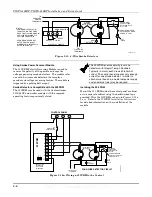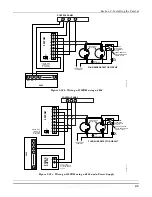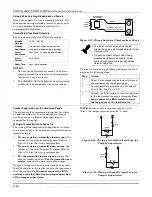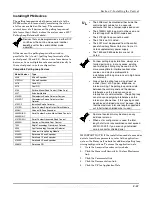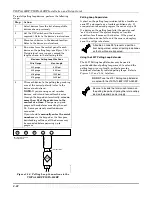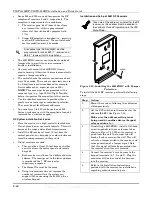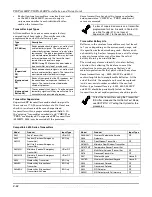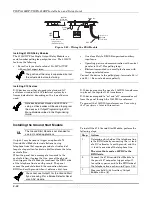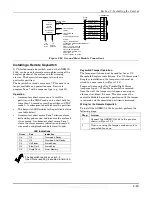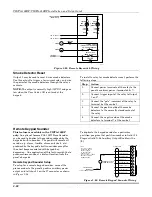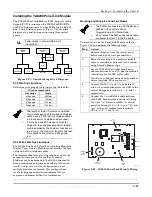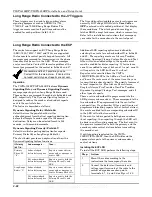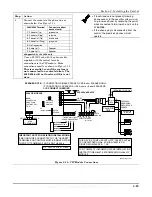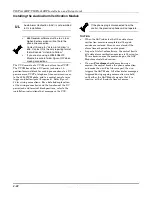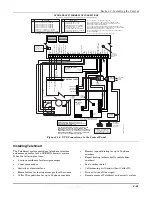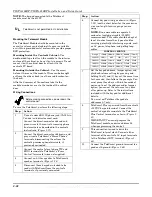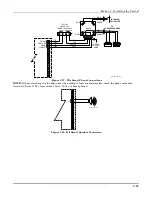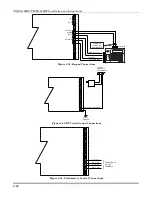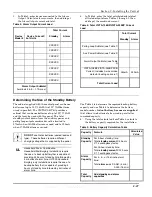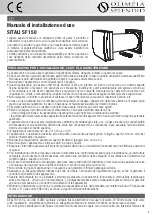
VISTA-128BP/VISTA-250BP Installation and Setup Guide
3-22
Long Range Radio Connected to the J7 Triggers
These triggers may be used to trip auxiliary alarm
signaling equipment such as ADEMCO’s 7720,
7720ULF, and 7920SE Long Range Radios. The
triggers are common to all partitions and must be
enabled for each partition (field 2
✳
20).
The fire and burglary/audible panic alarm triggers are
normally LOW and go HIGH until a
User Code +
OFF
is entered in all enabled partition(s) that display
these conditions. The silent panic/duress trigger
latches HIGH, except for duress, which is momentary.
Refer to the installation instructions that accompany
your radio for the connections to the control panel.
Long Range Radio Connected to the ECP
The control can support an ECP Long Range Radio
(LRR) (7820, 7835C, 7845C and 7845i are supported)
that connects to control panel’s keypad terminals. All
messages programmed for transmission via the phone
lines may also be sent via the LRR. These messages
are transmitted in Contact ID format regardless of the
format programmed for the control in fields 45 and 47.
We recommend that, if possible, you use
Contact ID for the main dialer. If Contact ID is
not used, certain types of reports are not sent.
Operation
The VISTA-128BP/VISTA-250BP features
Dynamic
Signaling Delay
and
Dynamic Signaling Priority
message reporting when Long Range Radio is used.
These options are accessed through data fields
✱
56 and
✱
57, respectively. The Dynamic Signaling feature is
designed to reduce the number of redundant reports
sent to the central station.
The feature is described as follows:
Dynamic Signaling Delay
(Field
✱
56)
Select the time the panel should wait for
acknowledgment from the first reporting destination
before it attempts to send a report to the second
destination. Delays can be selected from 0 to 225
seconds, in 15-second increments.
Dynamic Signaling Priority (Field
✱
57)
Select the initial reporting destination for reports,
Primary Dialer
(0)
or Long Range Radio
(1)
.
The chart below provides an explanation of how the
Dynamic Signaling feature functions.
If Priority
(
✱
57) is…
And message is… Then…
Acknowledged
before delay expires
Report is removed from
queue and no message is
sent to LRR.
Primary
Phone No.
("0")
Not acknowledged
before delay expires
Report is sent to both the
Primary Phone No. and
LRR.
Acknowledged
before delay expires
Report is removed from
queue and no message is
sent to Primary Phone No.
Long Range
Radio ("1")
Not acknowledged
before delay expires
Report is sent to both the
Primary Phone No. and
LRR.
Additional LRR reporting options are defined by
selecting the events for each subscriber ID in fields 58
and 59. The reporting events are Alarms, Troubles,
Bypasses, Openings/Closing, System Events, and Test.
Also, within an enabled category, the specific event
must be enabled for dialer reporting. If, for instance,
zone 10 is enabled to report, but zone 11 is not, zone 10
will report via the LRR, but Zone 11 will not.
Reports are transmitted from the VISTA-
128BP/VISTA-250BP to the LRR on a “first in/first
out” basis. If events occur at the same time, they are
transmitted in order of priority. The priority from most
to least important is : Fire Alarms, Panic Alarms,
Burglary Alarms, Fire Troubles, Non-Fire Troubles,
Bypasses, Openings/Closings, Test messages, and all
other types of reports.
There are two subscriber IDs programmed into the
LRR: primary and secondary. These correspond to the
two subscriber ID’s programmed into the control for
each partition. If a subscriber ID for a partition is not
programmed (disabling reports to that central station),
the events enabled for the corresponding subscriber ID
in the LRR will not be transmitted.
If the event is to be reported to both phone numbers
(dual reporting), then reporting through the LRR will
be done in an alternating sequence. The first event in
the queue is transmitted to both the primary and the
secondary radio central stations before transmitting
the second event.
If split reporting is selected for the VISTA-
128BP/VISTA-250BP, then the LRR will send the
appropriate reports to the primary and secondary
central stations.
Installing the ECP LRR
To install the ECP LRR, perform the following steps:
Step Action
1
Mount the radio according to the
instructions that accompany the radio.
2
Connect the data in/out terminals and
voltage input terminals of the radio to the
control’s keypad connection points,
terminals 6, 7, 8, and 9. See
Figure 3-29.
WWW.DIYALARMFORUM.COM
WWW.DIYALARMFORUM.COM

